New research takes efficiency of biological sensing to record level
Latest FLOWER device application could lead to better health outcomes and diagnostics.

In the University of Arizona’s Little Sensor Lab, Judith Su and collaborators use ultrasensitive optical sensing for a wide variety of applications.
University of Arizona researchers have developed a new biological sensing method that can detect substances at the zeptomolar level, an astonishingly miniscule amount.
This level of sensing, immediately useful for drug testing and other research, has the potential to make new drug discoveries possible. Eventually, the advance could lead to portable sensors that can detect environmental toxins or chemical weapons, monitor food quality, or screen for cancer. A paper laying out the results was published in Nature Communications Aug. 28.
Judith Su, associate professor of biomedical engineering and optical sciences, led the research for the UA, collaborating with Stephen Liggett from the University of South Florida. Their method uses the label-free FLOWER device, invented by Su, to pick up target compounds at zeptomolar (10-21) concentrations and without the current need for labeling – adding a fluorescent or radioactive tag to make a target compound stand out during testing.
“In certain applications, it can be really difficult or impossible to put these tags on, and they can increase cost. For things like small molecule drug screening, sometimes the tags can interfere with the results,” said Su, also an associate professor at the BIO5 Institute.
This article was originally published in UA News.
